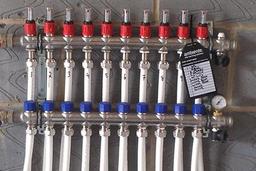
Plumbing Phase 3 (Learning Tool & Quiz)
Quiz by Joe Fantini
Feel free to use or edit a copy
includes Teacher and Student dashboards
Measure skillsfrom any curriculum
Tag the questions with any skills you have. Your dashboard will track each student's mastery of each skill.
- edit the questions
- save a copy for later
- start a class game
- automatically assign follow-up activities based on students’ scores
- assign as homework
- share a link with colleagues
- print as a bubble sheet
- Q1
Name the most important factors when installing Solar Panels
The Size of Solar Panel, Watts per M2, Shading, and Suitability of Structure
Roof Orientation & Pitch, Energy Needs, Roof Condition, Sun Exposure, and Finance
Location in the UK, Available Space, Installation Location, and Compliance with Building Regulations A, B, C, E, L and P
30s - Q2
What are the 2 types of Solar Thermal collectors that heat the collection fluid slightly differently.
Heat Absorbent Collectors and Evacuation Tube Collectors
Flat Plate Collectors and Evacuated Tube Collectors
Absorber Plate Collectors and Eleven Tube Collectors
Heat Transfer Collectors and Elevated Tube Collectors
30s - Q3
The Heat Transfer Fluid within a Solar Thermal Heating System will contain water and normally, what other liquid?
Glycinin
Cyclol
Charcoal
Glycol
30s - Q4
Where would you find information regarding the percentage of Glycol required in the system?
The Manufacturer's Instructions
On the Back of the Glycol Container
50/50
Ask the Customer
30s - Q5
How does the Differential Temperature Controller (DTC) work, connected to the Solar Collector (high level) and the Hot Water Cylinder (low level)?
It monitors the temperature at both points of the system.
DTC controls the water level
It monitors the hot water only
It controls the amount of heat within the Solar Panel only
30s - Q6
Generally, the minimum wind speed required for a wind turbine to start operating is around 7 to 10 miles per hour (mph). This speed is known as the cut-in speed. On the other hand, the maximum wind speed that a wind turbine can withstand without getting damaged is usually around 70 to 100 mph.
falsetrueTrue or False30s - Q7
Wind Turbines harness energy from the wind and turn it into electricity. A micro-wind turbine installed on a suitable site could easily generate more power than would be consumed on-site
truefalseTrue or False30s - Q8
What is the image below?
Isolation Valve
Pressure Reducing Valve
RPZ
Motorised Valve
30s - Q9
What type of source of renewable energy generates both Electricity and Thermal energy
ASHP
Combined Heat and Power Unit
Gas Boiler
Wind Turbines
30s - Q10
Look at the Image: What are some of the most common symptoms of Carbon Monoxide Poisoning?
Paralysed, Blurred Vision and Deafness
Headaches, Dizziness and Fatigue
Thirsty, Hungry and Angry
Irritability, Unable to Breath and Clumsiness
30s - Q11
Which Approved Document provides guidance for Energy Efficiency: conservation of fuel and power?
Approved Document F
Approved Document B
Approved Document L
Approved Document M
30s - Q12
Any Environmental Technology System comes under many Acts, Building Regulations and British Standards. Before any work that increases the size of the property, changes the use of the property or sometimes installing items externally, you may need to apply for 'Planning Permission' from the local authority, via which particular legislation?
Town and Country Planning Act 1990
Town and County Act 1990
Town and Tree Act 1990
Town and Out Act 1990
30s - Q13
Which body is responsible for checking that Building Regulations have been met and the person carrying out the installation is responsible for ensuring that approval has been obtained?
Local Council Building Inspectors (LBCI)
The Building Control Office (BCO)
Local Authority Building Control (LABC)
Building Control
30s - Q14
Which body bought Micro-Renewable Energy Systems in-line with the requirements of Building Regulations, even if planning permission is not required because the installation comes under the 'permitted development.'
The Climaxed Change and Sustainable Energy Act 2016
The Climate Change and Suitable Energy Act 2006
The Climate Change and Sustainable Energy Act 2016
The Climate Change and Sustainable Energy Act 2006
30s - Q15
Which British Standard are used for the requirements for electrical installations?
BSEN 7671
7671
BSI 7671
BS 7671
30s